ARCHIVED - Annual Report 2012 to Parliament
This page has been archived on the Web
Information identified as archived is provided for reference, research or recordkeeping purposes. It is not subject to the Government of Canada Web Standards and has not been altered or updated since it was archived. Please contact us to request a format other than those available.
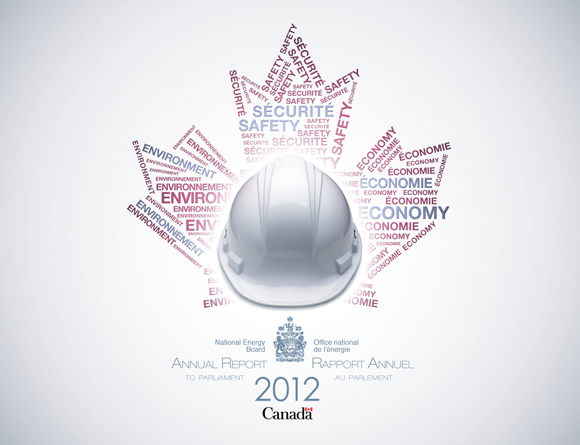
Copyright/Permission to Reproduce
ISSN 1498-8496

Purpose
We regulate pipelines, energy development and trade in the Canadian public interest[1].
Vision
The NEB is active and effective in Canada’s pursuit of a sustainable energy future.
Goals
- NEB-regulated facilities and activities are safe and secure.
- The environment is protected throughout the lifecycle of NEB-regulated facilities and activities.
- Canadians benefit from efficient energy infrastructure and markets.
- The rights and interests of those affected by NEB-regulated facilities and activities are respected.
Values
- Integrity: We are fair, transparent, and respectful.
- Regulatory Leadership: We are responsive, proactive and innovative.
- Accountability: We are accountable and support each other to deliver timely, high quality results.
Strategies
- We engage Canadians.
- We hold those we regulate accountable for results in the public interest.
Chair's Message
 Keeping the public safe, protecting the environment, promoting economic efficiency and having meaningful conversations with Canadians: all great reasons to come to work every day. As Canada’s national energy regulator, these have always been priorities.
Keeping the public safe, protecting the environment, promoting economic efficiency and having meaningful conversations with Canadians: all great reasons to come to work every day. As Canada’s national energy regulator, these have always been priorities.
We take every opportunity to verify that the pipelines we regulate are operating safely. We require all pipeline companies to anticipate, prevent, manage and mitigate potentially dangerous conditions associated with their pipelines. All incidents are preventable and we expect the companies we regulate to strive for zero. Equally important is the commitment to maintain an open channel of dialogue with you as Canadians. We will continue to listen to your priorities so that we may evolve in a way that matches your expectations.
The year 2012 marked one of change for the NEB. The passing of the Jobs, Growth and Long-term Prosperity Act included some of the most significant changes to the NEB Act since its implementation in 1959. Since July, the Board has been working hard to implement these legislated changes. This work will support the NEB’s pursuit of continual improvement in serving Canadians.
Under the new legislation, we must now set time limits for regulatory reviews and make sure that these time limits are met. This provides the public with enhanced certainty around regulatory proceedings and NEB project reviews. The Board has also been equipped with new compliance enforcement tools in the form of administrative monetary penalties (AMPs). AMPs will enable us to impose financial penalties on companies or individuals for non-compliances related to safety and the environment. Further, the Board received additional funds to continually improve pipeline safety. With these funds, the NEB is increasing inspection activities by fifty per cent and are doubling comprehensive audits. You will see more information on these and other regulatory changes throughout this report as well as how these tools better equip the NEB to protect Canadians and the environment.
The NEB administers oil and gas exploration and production activities in Canada’s North. In the Arctic Review Report released in 2011, we made a commitment to the people of the North to continue the meaningful dialogue we had with them during the Arctic Review. We are delivering on this commitment. We have expanded Arctic activities this past year through engagement with northern communities, youth, governments, other regulatory bodies, and land claim institutions. As part of this commitment, we signed Memoranda of Understanding with two Nunavut Boards and two Inuvialuit Boards that will promote regulatory collaboration in the North.
I am particularly proud of our visits to high schools and colleges in the North. As future leaders, young people have a unique perspective that we believe needs to be listened to, now. We have encouraged them to speak up, and to express their concerns and points of view on the energy matters we deal with in the North.
This year the NEB was again recognized as one of Canada’s Top 100 Employers (for the third year in a row and the fourth time). I am incredibly proud of this recognition, but for me it is not just about us as an employer – we are a “Top 100 Team”. This organization is fortunate enough to be made up of truly remarkable staff and Board Members doing amazing work. We were also named as a top Family Friendly Employer in Canada. Supporting families is key to the success of any organization and we are honored to have received this designation.
Looking forward to 2013, I am confident the National Energy Board will continue to be a strong regulator of Canada’s energy sector. That is our job. The companies we regulate must perceive compliance monitoring and enforcement to be unrelenting and ever present. A regulator must never be satisfied that it has done all it can to protect people and the environment. All the Board Members and approximately 400 staff at the NEB take this responsibility very seriously. We remain committed to regulating in the public interest and listening to the evolving priorities of Canadians whom we serve.
Original signed by
Gaétan Caron, Chair and CEO
Major Pipeline Systems and Frontier Activities
Regulated by the National Energy Board
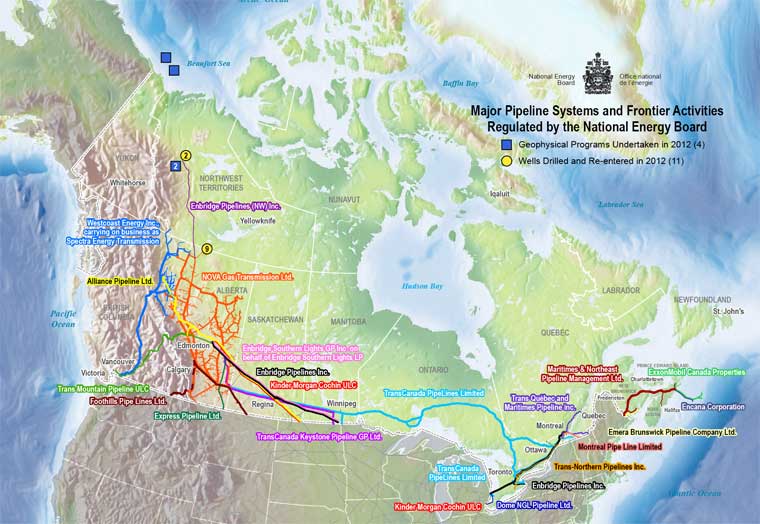
Our Roles And Responsibilities
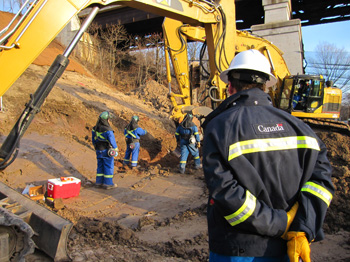 The National Energy Board (NEB or Board) is an independent federal regulator established in 1959. Our mandate is to promote safety and security, environmental protection and economic efficiency in the Canadian public interest, in the regulation of pipelines, energy development and trade. The Board reports to Parliament through the Minister of Natural Resources.
The National Energy Board (NEB or Board) is an independent federal regulator established in 1959. Our mandate is to promote safety and security, environmental protection and economic efficiency in the Canadian public interest, in the regulation of pipelines, energy development and trade. The Board reports to Parliament through the Minister of Natural Resources.
The Board is funded by Parliament through the Appropriations Act, with approximately 90 per cent of its costs recovered by the Federal government from the companies whose energy facilities are regulated by the Board. Financial statements for cost recovery purposes are prepared annually and audited by the Office of the Auditor General. The audited financial statements for cost recovery purposes can be found on our website.
In addition to the Cost Recovery Financial Statements, which are prepared on a calendar year basis, the NEB prepares financial statements that form part of the Public Accounts of Canada. Additional information on the NEB’s budgets and plans may be found on our website. Table 1 provides an overview of NEB financial and human resources.
Table 1 - NEB Expenditures and Staff (by fiscal year)[2]
| Fiscal Year (1 April to 31 March) | Expenditures (Million $) |
Staff (Full-Time Equivalents) |
| 2010-2011 | 58.8 | 374 |
| 2011-2012 | 64.4 | 393 |
| 2012-2013 | 68.4 | 401 |
In 2012, we regulated approximately 98 companies, which operate approximately 73,000 kilometres of pipelines and approximately 1,400 kilometres of international power lines across Canada. These pipelines shipped approximately $106.3 billion[3] worth of crude oil, petroleum products, natural gas liquids and natural gas to Canadian and export customers at an estimated transportation cost of $6.9 billion. NEB-regulated international power lines transmitted approximately $2.2 billion of electricity into and out of Canada.
The main responsibilities of the NEB are established in the National Energy Board Act (NEB Act) and include regulating:
- The construction and operation of pipelines that cross international borders or provincial boundaries, as well as pipeline tolls and tariffs;
- The construction and operation of international power lines and designated inter-provincial power lines; and,
- Natural gas imports and exports, and crude oil, natural gas liquids (NGL) and electricity exports.
Additionally, the Board has regulatory responsibilities for oil and gas exploration and activities on frontier lands not otherwise regulated under joint federal/provincial accords. These regulatory responsibilities are under the Canada Oil and Gas Operations Act (COGO Act), and certain provisions of the Canada Petroleum Resources Act (CPR Act). These responsibilities apply to West Coast offshore, Northwest Territories, Nunavut, Arctic offshore, Hudson Bay, part of the Gulf of St. Lawrence, a portion of the Bay of Fundy and onshore Sable Island. The Board also has regulatory responsibilities under specific sections in the Northern Pipeline Act.
The NEB has environmental responsibilities under the NEB Act, Canadian Environmental Assessment Act, 2012 (CEAA 2012) and the Mackenzie Valley Resource Management Act (MVRMA). In addition, certain Board inspectors are appointed Health and Safety Officers by the Minister of Labour to administer Part II of the Canada Labour Code as it applies to facilities and activities regulated by the Board.
The Board also monitors aspects of energy supply, demand, production, development and trade that fall within the jurisdiction of the federal government (see Energy Markets in 2012).
More information on the background and operations of the NEB can be found on the Board’s website, www.neb-one.gc.ca.
Jobs, Growth and Long-term Prosperity Act - Changes to NEB Legislation
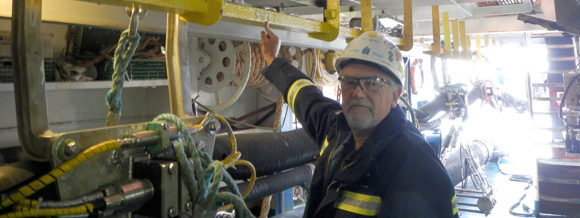
In the summer of 2012, the Government of Canada made significant legislative changes to the NEB Act. This was one of the most significant amendments to the NEB Act since it was introduced in 1959.
The Jobs, Growth and Long-term Prosperity Act received Royal Assent on 29 June 2012, with portions of the Act coming into force on 6 July 2012. The Act includes legislative changes to a number of Acts, including the NEB Act and CEAA 2012. The intent of this legislation is to support job creation and economic growth while maintaining strong environmental protection.
Key changes to the NEB Act that came into effect in July 2012 include:
- A fixed beginning-to-end time limit of 18 months for most NEB project hearings. From receipt of a complete application, the NEB will have 15 months to complete the project assessment. For applications requiring a certificate, from this point the Governor in Council (GiC) will have three months to make a decision;
- The GiC will make the decision to approve or deny all major pipeline projects. The NEB’s report on a project will include conditions to be attached to any certificate issued. The Board makes the final decision as to what its recommendation will be, and what terms and conditions would apply;
- The Chair of the NEB will set time limits for specific project reviews within the maximum 15 month time limit. The Act provides the Chair with a variety of tools to make sure time limits are met and applications are dealt with in a timely manner;
- For projects designated under CEAA 2012 the NEB will conduct an environmental assessment pursuant to that Act. For projects not designated under CEAA 2012, the NEB will continue to conduct an environmental assessment as a part of its public interest mandate under the NEB Act;
- Factors that the Board may consider when reviewing export licences for natural gas and oil have been changed. The requirement to hold a hearing for gas export licences has also been removed;
- Section 112 of the NEB Act now includes the option of pursuing criminal prosecution for unauthorized activity on NEB-regulated pipeline rights of way;
- For major projects, the NEB must hear concerns from those persons or groups who are directly affected by the project. The Board may also hear from those who have relevant information or expertise about the project; and,
- The NEB Act previously restricted the number of temporary Board Members to six. The amended NEB Act does not have this restriction. This increased flexibility means that more temporary Members may be appointed, allowing the Board to be more effective and responsive to workload pressures and time limits for reviews.
Changes to the NEB Act expected to come into effect in July 2013 include:
- Authorization for the Board to establish a system of administrative monetary penalties (AMPs); and,
- Requirement for the Board to consider the effects of pipeline and power line crossings of navigable waters; such works will not require separate authorizations under the Navigable Waters Protection Act.
Some of the key areas identified above will be highlighted with more detail throughout this report.
The NEB will continue to conduct proceedings in an open, fair and impartial manner. The Board will also continue to conduct an independent, fair and accessible environmental assessment and regulatory review process for all pipeline projects. For major pipeline projects we will recommend whether or not the GiC should approve or deny a project, as well as terms and conditions in the public interest.
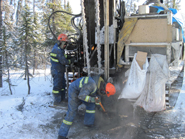
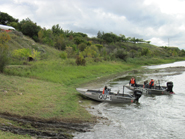
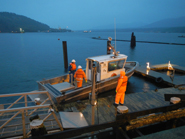
Safety, Security and the Environment
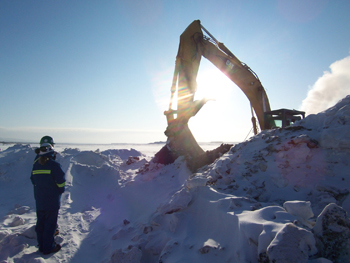 The safety of Canadians and protection of the environment in the construction, operation and abandonment of pipeline facilities regulated by the NEB are the Board’s top priorities, and have been a part of our mandate since 1959. We hold those we regulate accountable so that the safety of Canadians and the environment is protected.
The safety of Canadians and protection of the environment in the construction, operation and abandonment of pipeline facilities regulated by the NEB are the Board’s top priorities, and have been a part of our mandate since 1959. We hold those we regulate accountable so that the safety of Canadians and the environment is protected.
In 2011, the NEB created an Action Plan on Safety and Environmental Protection to improve outcomes in four strategic areas of safety and environmental protection. The four areas are:
Worker Safety Proactive safety management and a culture of safety are values for industry |
Integrity of Installations Prevention of spills and releases is the focus of industry systems |
| Safety and Environmental Protection Outcomes | |
Damage Prevention Industry promotes awareness of safe work practices near pipelines and creates the conditions for the NEB to hold people accountable |
Emergency Preparedness Systems are in place to minimize risk to people and the environment in the event of an emergency |
The key actions completed in 2012 with respect to the Action Plan were:
- Release of a plan for regulatory improvement for prevention of damage to pipelines by third parties; and,
- Release of guidance on compliance and enforcement for damage prevention.
As a result of the Action Plan, information about enforcement actions is readily available to Canadians. The NEB’s approach to reports of unauthorized crossings near or over pipelines is available on our website along with safety and environmental protection enforcement actions taken. Further information regarding AMPs is discussed later in this chapter.
Reportable Incidents
The Onshore Pipeline Regulations, 1999 (OPR-99) define incident or release of product as an occurrence that results in:
- the death of or serious injury to a person;
- a significant adverse effect on the environment;
- an unintended fire or explosion;
- an unintended or uncontained release of low vapour pressure hydrocarbons in excess of 1.5 m³;
- an unintended or uncontrolled release of gas or high vapour pressure hydrocarbons; or,
- the operation of a pipeline beyond its design limits as determined under Canadian Standards Association (CSA) Z662 or CSA Z276 or any operating limits imposed by the Board.
Compulsory incident reporting under the OPR-99 alerts the NEB of environmental and safety incidents and is used to provide compliance oversight. This information is also supplemented by the voluntary reporting initiative for safety and environmental performance indicators captured in the report issued by the NEB in December 2011, Focus on Safety and the Environment: A Comparative Analysis of Pipeline Performance, 2000-2009. The next such report is expected to be issued in 2013. Injury frequencies, incident trends and other indicators provide data which allows the NEB to identify where improvement is needed. The NEB follows up on every incident that is reported to determine if company corrective actions are appropriate.
NEB staff conducted on-site responses to three incidents in 2012 (in 2011 Board staff also responded to three incidents). These incidents in 2012 were:
- A leak from a tank at TransMountain Pipeline ULC’s Sumas Tank Farm, Abbotsford, British Columbia (B.C.);
- a rupture on Westcoast Pipeline’s Nig Creek Pipeline near Wonowon, B.C.; and,
- a serious injury to a Westcoast Pipeline employee who was severely burned while performing maintenance.
Companies are also required to report all hazardous occurrences, as defined by the Oil and Gas Occupational Safety and Health Regulations under the Canada Labour Code, Part II for activities in frontier lands. In 2012, there were 15 hazardous occurrences, down from 21 in 2011 (Figure 2). Fourteen of these hazardous occurrences were reportable spills and one was due to a fire on a fibreglass production tank. None of the hazardous occurrences involved injuries. The Board has compliance verification activities in place to make sure the companies involved apply appropriate preventive and corrective actions, including adequate remediation.
Figure 2 - Reported Hazardous Occurrences
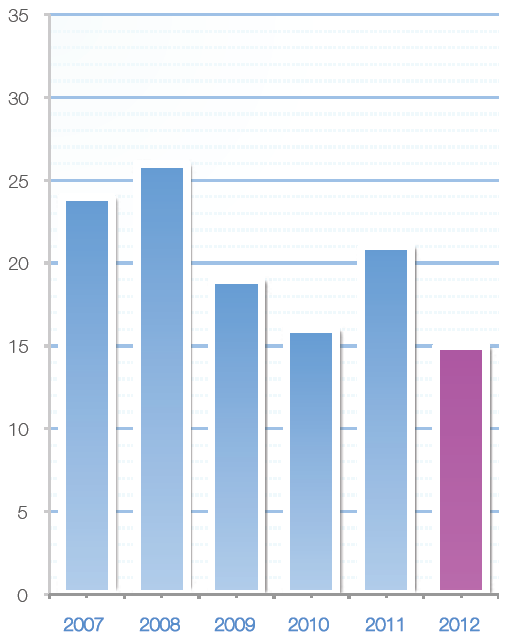
The National Energy Board holds regulated companies accountable for anticipating, preventing, mitigating and managing incidents of any size or duration. We expect regulated companies to develop a strong safety culture as part of their management system. Any release of product is considered unacceptable by the Board. When we are notified of a release of product, our top priorities are the safety and security of people, and the protection the environment.
In 2012 there were 134 reportable incidents as compared to 102 in 2011[4]. There have been zero fatalities and six injuries. The NEB is committed to working with companies and other stakeholders to find ways to improve safety performance in order to meet the annual target of zero incidents and injuries. Figure 3 illustrates the number of OPR occurrences by type.
Figure 3 - OPR Incidents by Occurrence Type
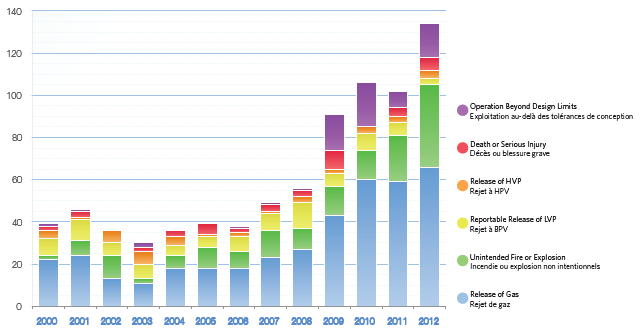
Damage Prevention
Preventing damage to pipelines is a shared responsibility. Pipeline companies are required to ensure that people know how to safely conduct activities, such as excavation and construction near pipelines, and people planning activities near pipelines are required to “Call Before You Dig.” The NEB provides regulatory oversight of activities such as the examples provided above, and must create the conditions necessary to hold people accountable for carrying out these responsibilities.
The NEB’s regulatory framework for damage prevention is made up of a number of regulatory tools designed to make sure that companies and individuals are effective in managing safety and environmental protection in their day-to-day interactions with pipelines. The NEB’s compliance monitoring and enforcement activities support this framework and are used to promote compliance. The Board’s Plan for Improving Regulatory Clarity for this framework, released in February 2012, focuses on making sure that those planning work near pipelines have the information they need to make safe choices.
As the Federal Regulatory Champion for the Canadian Common Ground Alliance (an organization dedicated to pipeline damage prevention solutions), the NEB will continue to collaborate with all those involved in promoting safe work practices around pipelines. In addition to regulatory initiatives to clarify the roles and responsibilities of everyone involved, in 2013 the NEB will commence work on a national standard for damage prevention. Through use of a consensus-based Canadian Standards Association (CSA) committee, the Board will work jointly with representatives of the oil and gas and construction industries, landowners, locators, one-call centres, and other governments to provide technical support in the development of CSA-Z247. This national standard will provide minimum requirements, guidance, and best practices for the development of damage prevention programs for the petroleum and natural gas industry.
To provide clarity around enforcement, in 2012, the NEB developed a clear model explaining how companies must report unauthorized activities near pipelines, and how the Board will respond to these reports through the Compliance and Enforcement Initiative. The purpose of the model is to provide transparency and consistency in the application of enforcement tools available to the NEB. Since releasing the model, the NEB has been using the lessons learned from the standardized reports it has received to measure how its regulatory framework is working and to identify areas for improvement. The model also helps to identify patterns of non-compliance so that compliance verification activities for following years can be planned and prioritized.
In 2012 there were 127 reported unauthorized activities related to NEB regulated facilities, up from 73 in 2011. Figure 4 is an overview of unauthorized crossing activities by province in 2012.
Figure 4 - Unauthorized Crossing Activities by Province
British Columbia : 52, Alberta : 15, Saskatchewan : 2, Manitoba : 1, Ontario : 30, Quebec : 25, New Brunswick : 1, Nova Scotia : 1.
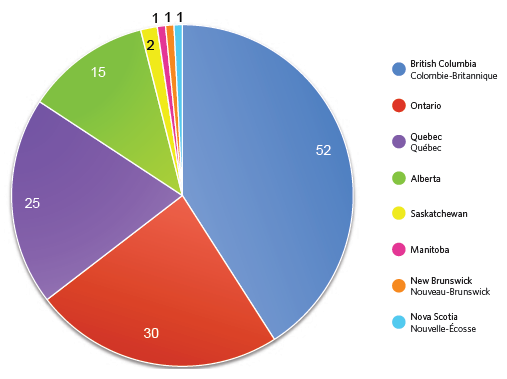
The number of reported unauthorized activities fluctuates from year to year due to a number of factors. The number may grow as development and construction activity increases around pipelines. Also, increased compliance activities by the NEB has resulted in companies becoming more aware of our reporting requirements.
The Board strives for continual improvement in this area. Everyone involved must work to reduce unauthorized activities, with the ultimate goal of seeing none at all.
Safety Forum - June 2013
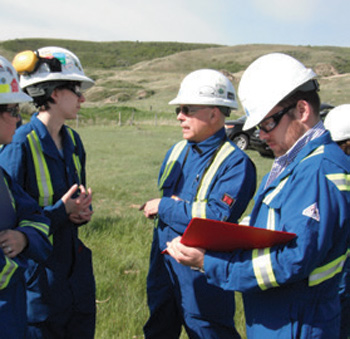 The Board is strongly committed to taking leadership on emerging pipeline and facility safety and environmental protection issues. As a key component of the NEB’s Action Plan on Safety and Environmental Protection, the Board will be hosting a forum on pipeline and facility safety on the 5th and 6th of June 2013
in Calgary, Alberta. As part of the Safety Forum, the NEB is committed to engaging interested regulators and industry participants in a dialogue to further the sharing of information.
The Board is strongly committed to taking leadership on emerging pipeline and facility safety and environmental protection issues. As a key component of the NEB’s Action Plan on Safety and Environmental Protection, the Board will be hosting a forum on pipeline and facility safety on the 5th and 6th of June 2013
in Calgary, Alberta. As part of the Safety Forum, the NEB is committed to engaging interested regulators and industry participants in a dialogue to further the sharing of information.
The Safety Forum presents an opportunity for the NEB, other regulators and oil and gas companies to explore emerging issues in the oil and gas industry for safety management. Key issues are corporate leadership’s role in building and maintaining a safety culture, integration within management systems and effective safety performance measurement.
In September of 2012, the NEB engaged with a group of international regulators at the International Pipeline Conference and again in October with Canadian safety regulators to further discuss emerging safety and environmental protection issues.
Management Systems: Building a Safety Culture
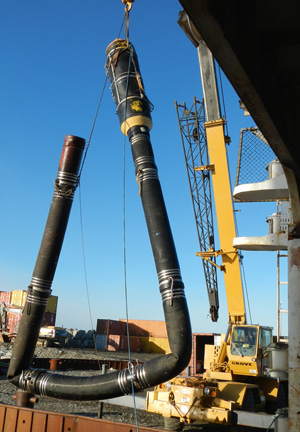 Safety culture happens when everybody believes in it, talks about it, promotes it and lives it. The Board is convinced that proactive safety management and a culture of safety will reduce incidents that result in fatalities and injuries, the impact of incidents on the environment and property damage resulting from incidents. The pipeline industry’s safety performance is receiving intense scrutiny and continual improvement of even good safety records is necessary. We require that companies we regulate have an approach to operating that is systematic, comprehensive and proactive in building and managing a culture that emphasizes safety, minimizes risk, and satisfies regulatory requirements. The Board’s OPR-99 requires companies to develop and implement management and protection programs. The NEB conducts audits, inspections, and other assessments of regulated companies to test the adequacy and effectiveness of their management and environmental protection programs.
Safety culture happens when everybody believes in it, talks about it, promotes it and lives it. The Board is convinced that proactive safety management and a culture of safety will reduce incidents that result in fatalities and injuries, the impact of incidents on the environment and property damage resulting from incidents. The pipeline industry’s safety performance is receiving intense scrutiny and continual improvement of even good safety records is necessary. We require that companies we regulate have an approach to operating that is systematic, comprehensive and proactive in building and managing a culture that emphasizes safety, minimizes risk, and satisfies regulatory requirements. The Board’s OPR-99 requires companies to develop and implement management and protection programs. The NEB conducts audits, inspections, and other assessments of regulated companies to test the adequacy and effectiveness of their management and environmental protection programs.
Amendment to the Onshore Pipeline Regulations, 1999 (OPR-99)
The Board’s current pipeline regulations, the OPR-99, brought into force in 1999 and updated over the years along with Canadian Standards Association revisions, are effective at defining a baseline management system. While innovative for their time, the NEB believes more can be done to provide clarity and additional details around what is expected. This is why we are introducing amendments to our regulations.
In 2011, we released a Proposed Regulatory Change (PRC) [Filing A30543] that provided clarification on the Board’s expectation that a pipeline company’s approach to operating is systematic, comprehensive and proactive in managing risks in order to promote safety, security and environmental protection. On 27 October 2012, the regulatory amendment with management system provisions was pre-published in Canada Gazette, Part I for a 30-day comment period. The Board will review and consider the comments received and the amendments will continue to follow the federal regulatory development process. The regulatory amendment includes several elements designed to advance safety culture, including a requirement for the designation of a company officer who is personally accountable for the management system and the achievement of outcomes related to safety and environmental protection. We believe compliance with these provisions will provide the foundation for a more rigorous, industry-wide culture of safety.
Emergency Management
In 2011, the Office of the Auditor General (OAG) conducted an audit of the Board’s Emergency Management Program. The OAG observed that overall the Board has designed a sound risk-informed approach to monitor regulated companies’ adherence to regulations and Board expectations. In its report, the OAG recommended that the NEB establish and implement a clear action plan that sets out specific steps to improve the Board’s risk-informed model; practices and procedures for monitoring compliance; documenting compliance; and procedures for follow-up on non-compliances. Following the audit and subsequent recommendations, the NEB established a corrective action plan (CAP) to address the audit findings, and committed to completing the CAP by April 2012. We completed all action items outlined in the CAP before the end of April 2012.
In the first part of 2012 the Board focused efforts on: developing a process to review baseline critical information in a company’s Emergency Procedures Manual (EPM); strengthening the Board’s compliance verification processes; training staff in the updated processes; and reviewing the compliance risk model. The NEB also followed-up on deficiencies in company EPMs and enhanced risk-informed planning by creating a process to evaluate the effectiveness of the risk model. The Board is committed to continual improvement in its emergency management program.
In addition to completing the CAP in 2012, we have also completed Critical Information Checks on all company’s EPMs to assess whether they have included baseline information. NEB staff also evaluated 13 simulated emergency response exercises and provided feedback on how to improve companies’ plans and responses.
Through the Emergency Management Program, the NEB focuses on overseeing the compliance and continual improvement of regulated companies’ emergency preparedness and response programs. Since April 2012, the NEB has been working with the Canadian Standards Association (CSA) and emergency management experts to draft an emergency preparedness and response standard for the petroleum and natural gas industry. The standard is expected to be published in 2014. This will be the first standard specific to emergency response for the petroleum and natural gas pipeline industry. NEB staff also continue to participate on the CSA Z1600 (Emergency and Continuity Program Standard) Technical Committee.
Compliance Verification Activities Completed
In 2012, we conducted a total of 253 compliance activities related to security, public safety and environmental protection as seen in Table 5. The Board remains on track to completing 150 inspections and six audits by the end of fiscal 2012-2013.
Table 5 - 2012 NEB Compliance Activites
(1 January 2012 to 31 December 2012)
| Compliance Activity | Completed |
| Inspections | |
| Safety | 35 |
| Integrity | 33 |
| Environmental | 66 |
| Security | 3 |
| Subtotal: | 137 |
| Emergency | 15 |
| Emergency Procedures Manual Review | 19 |
| Compliance Meetings | 59 |
| Audits | 2 |
| Report Reviews | 21 |
Inspection and Audits - Increased Resources
Safety has been a critical part of the Board’s mandate since its creation in 1959. As part of the Jobs, Growth and Long-term Prosperity Act the Government of Canada provided the NEB with an additional $13.5 million to hire additional staff over the next two years to strengthen the Board’s oversight of pipeline safety. The funding will allow the Board to increase the number of annual inspections for NEB-regulated companies from 100 to 150, and to double the number of management system audits from three to six per year.
Administrative Monetary Penalties (AMPs)
Amendments to the NEB Act through the Jobs, Growth and Long-term Prosperity Act will authorize the Board to create a system of AMPs through regulations. AMPs are financial penalties the Board may impose on companies or individuals for non-compliance with the NEB Act, regulations, decisions, permits, orders, licences or certificate conditions.
The Board’s proposed approach is to establish two categories of violations, with two baseline penalties for each category based on whether the violation is committed by an individual or company. The new AMP sections in the NEB Act set out the maximum daily penalties: for individuals the maximum daily penalty is $25,000 for each violation, and for companies the maximum daily penalty is $100,000 per violation.
The Act stipulates that each day that a violation continues is considered to be a separate violation. This means that separate penalties could be issued per infraction, per day with no maximum total financial penalty.
In the summer of 2012, the NEB released a discussion paper to provide an overview of key elements of a proposed AMPs system under the NEB Act, and to seek comments from interested persons. During the public comment period Board staff met with several groups to discuss the AMPs proposal, answer questions and solicit feedback. A webinar was also held on 6 September 2012 with numerous organizations and individuals from across the country.
The results of these consultations were incorporated into a set of draft regulations that the Board pre-published in February 2013 in the Canada Gazette, Part I. Implementation of AMPs is planned for the summer of 2013.
The Public Interest
 The purpose of the NEB is to regulate pipelines, energy development and trade in the Canadian public interest. The NEB follows the evolution of the public interest by listening to what Canadians have to say about how energy infrastructure is developed and regulated, engaging them in meaningful dialogue about issues and solutions, and publically sharing information about regulatory initiatives.
The purpose of the NEB is to regulate pipelines, energy development and trade in the Canadian public interest. The NEB follows the evolution of the public interest by listening to what Canadians have to say about how energy infrastructure is developed and regulated, engaging them in meaningful dialogue about issues and solutions, and publically sharing information about regulatory initiatives.
Northern Engagement 2012-2013
In the past year the Board has continued to expand northern engagement activities through meetings with Northern communities, youth, governments, regulatory agencies, and land claim institutions. The Board remains committed to listening to those who would be most affected by drilling activities in Canada’s Arctic in support of realizing shared objectives for safety and environmental protection.
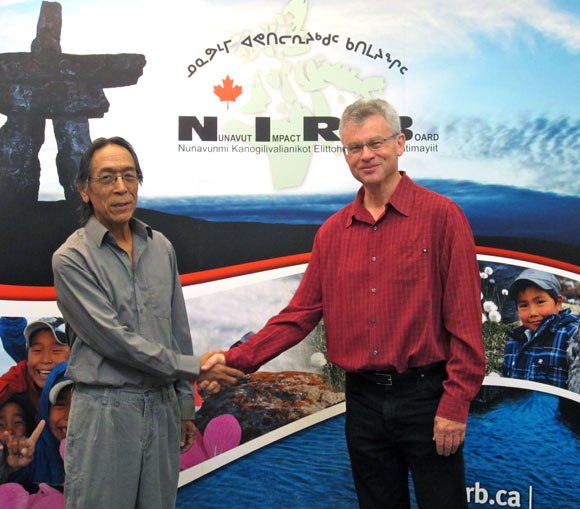
In August of 2012, the NEB signed Memoranda of Understanding (MOU) with the Nunavut Impact Review Board and Nunavut Water Board, and in November of 2012, with the Environmental Impact Screening Committee and the Environmental Impact Review Board for the Inuvialuit. These MOUs provide for technical training, information exchange, and regulatory coordination between the NEB and the Northern Boards.
In addition, the NEB partnered with Aboriginal Affairs and Northern Development Canada, and the Government of the Northwest Territories to organize over 20 focused outreach and engagement sessions with communities, land claim organizations, and government agencies to explain the NEB’s role in regulating oil and gas activities in the North, including proposed hydraulic fracturing operations in the Central Mackenzie Valley.
Similarly, in 2012, the Chair and CEO accompanied by Board Member David Hamilton and NEB staff, travelled with the President of the Qikiqtani Inuit Association to several Baffin Island communities to explain the NEB’s role in regulating offshore seismic exploration for oil and gas.
These northern engagement initiatives, together with the Board’s continuing participation in the NWT Board Forum, the Arctic Council, the Beaufort Regional Environmental Assessment and in emergency preparedness exercises (such as the CANUSNORTH exercise which is discussed in the following section), collectively respond to the Board’s commitment to working collaboratively with others in the responsible management of resources in the North for the benefit of all Canadians including those who live in the North.
CANUSNORTH 2012 Exercise
In August 2012 in Tuktoyaktuk, NT, the NEB participated in the CANUSNORTH table top exercise on a well control incident in the Canadian Beaufort Sea.
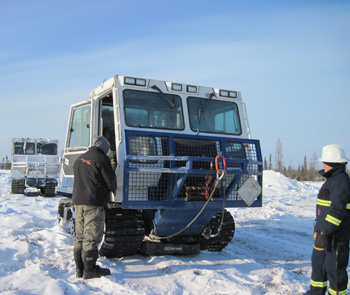 CANUSNORTH is the short form used to refer to the Annex of the Canada-United States Joint Marine Pollution Contingency Plan (JCP) that covers the Beaufort Sea. The JCP defines the roles and responsibilities of the various players who would participate in the cleanup efforts of a marine pollution incident (if it were to occur), in the contiguous waters between Canada and the United States.
CANUSNORTH is the short form used to refer to the Annex of the Canada-United States Joint Marine Pollution Contingency Plan (JCP) that covers the Beaufort Sea. The JCP defines the roles and responsibilities of the various players who would participate in the cleanup efforts of a marine pollution incident (if it were to occur), in the contiguous waters between Canada and the United States.
The NEB was a member of the Joint Design Team for the exercise with the Canadian Coast Guard, the US Coast Guard, Canadian Association of Petroleum Producers, Environment Canada, Inuvialuit Game Council, and the Inuvialuit Joint Secretariat.
The objectives of the exercise were to discuss the jurisdictional and financial implications of conducting a coordinated response under the CANUSNORTH Annex where the Canadian Coast Guard is not the lead agency for the spill, and to determine decision-making procedures for use of alternative countermeasures.
NEB Land Matters Group
The Board established a Land Matters Group (LMG) as a mechanism to increase the dialogue amongst members of the public, Aboriginal groups and industry who have interests in land matters and are impacted by the activities of NEB-regulated companies. LMG members may participate in the Steering Committee and topic-specific sub-committees that are supported by NEB staff and resources.
The purpose of the LMG is to bring together different perspectives, knowledge and expertise to:
- inform the Board on regulatory development, priority setting and program delivery decisions;
- build awareness and interest in land matters and encourage a fuller exchange of information between affected individuals and groups; and,
- promote and facilitate in-depth discussion and recommendations on land matters.
During 2012, the Land Matters Group Steering Committee met three times and:
- identified current or emerging land matters issues impacting interested parties;
- recommended improvements to regulating the facilities and/or activities of companies regulated by the NEB; and,
- recommended strategies for engaging Canadians on the Board’s damage prevention framework and draft AMPs regulations, among other initiatives.
The LMG’s first topic-specific sub-committee was also established in 2012. Through numerous meetings, the Public Involvement sub-committee refined the input gathered at the Board’s November 2011 workshop on Draft Expectations - Public Involvement Program [Filing A22289] and provided written recommendations to the Board. In its response the Board noted that many of the sub-committee’s recommendations were complementary to and supportive of Board initiatives in progress and committed to:
- enhancing compliance verification;
- enhancing public education and awareness; and,
- integrating components of the NEB Draft Expectation for Public Involvement into the NEB Filing Manual.
The Board also strongly encouraged industry to develop, adopt and promote best practices and training standards for land agent conduct and specified that it wanted the best practices guide developed in consultation with landowners.
Energy Infrastructure - Today and Tomorrow
 Canadians depend on the pipeline transportation system for a safe, reliable and efficient energy supply, now and in the future. The ability of this system to deliver natural gas, natural gas liquids (NGLs), crude oil, and petroleum products is also critical to Canada’s economy. The NEB is active and effective in Canada’s pursuit of a sustainable energy future by integrating relevant economic, environmental and social considerations when choosing a course of action.
Canadians depend on the pipeline transportation system for a safe, reliable and efficient energy supply, now and in the future. The ability of this system to deliver natural gas, natural gas liquids (NGLs), crude oil, and petroleum products is also critical to Canada’s economy. The NEB is active and effective in Canada’s pursuit of a sustainable energy future by integrating relevant economic, environmental and social considerations when choosing a course of action.
The NEB’s regulatory framework is designed to promote safety, security, environmental protection and efficient energy infrastructure and markets. Mandatory requirements encourage innovation where possible but also focus on specific design, operational practices or management methods when necessary. The regulatory framework supports a sustainable energy system that will meet Canadians’ needs today, while taking into consideration the needs of Canadians tomorrow.
Full Cycle Regulation
The NEB regulates and considers issues of design, construction, operation and abandonment of energy infrastructure facilities. In other words, the Board regulates from “start to finish”, and holds pipeline companies responsible for the full cycle cost of the pipelines they operate.
In May 2009, the NEB released a decision directing all NEB-regulated companies to begin setting aside abandonment funds and set out a five-year Action Plan in that regard. The five-year Action Plan contains steps which will facilitate the setting-aside and reporting on funds by 2015.
The five-year Action Plan is on track. In November 2011, all large regulated pipeline companies and many smaller ones filed their initial estimates of costs to abandon their pipelines. The Board held a public hearing in October and November of 2012 to examine the assumptions and cost estimates of the large pipeline companies. The Board will announce its Decision on these matters in February 2013.
In the first half of 2013, pipeline companies must file further applications regarding the timeframe in which abandonment related funds will be collected and how the funds will be set-aside and managed. Following Board decisions in 2014 on collection periods, set-aside mechanisms, and investment policies, companies will be required to report on funds collected starting in 2015.
Applications and Hearings in 2012
Companies regulated by the NEB are required to seek the Board’s approval to, among other things:
- construct and operate international and interprovincial pipelines and international power lines in Canada, along with related facilities and activities, or modify or abandon existing facilities;
- export crude oil, natural gas liquids and electricity, and export and import natural gas; and,
- establish pipeline tolls and tariffs.
For a large facilities application, the Board’s work begins when a company files a Project Description for the project. The NEB uses a Project Description to initiate pre-application activities. These include early public and Aboriginal engagement processes; initiating the NEB’s Participant Funding Program for the project; and where possible, seeking feedback on the timing of an oral public hearing. The NEB works with the federal Major Projects Management Office (MPMO) to ensure the timely and effective regulatory review of large NEB regulated projects.
We engage the public and Aboriginal groups who may be impacted by a project through the Board’s engagement staff (process advisors), who provide support to hearing participants, engage stakeholders, and share information about Appropriate Dispute Resolution, hearing processes, participant funding and methods of presenting information to the Board.
Applicants must submit applications or information that enable the Board to undertake a technical assessment of the various impacts of a project, and make an informed decision in the Canadian public interest that considers, among other things, present and future economic, environmental and social considerations. A written or oral hearing is usually held to consider applications for major projects. This allows the company proposing the project, and people or groups who are impacted, a chance to provide information and input regarding the project. Applicants can request a pre-application meeting with NEB staff to gain a better understanding of the application processes and regulatory requirements.
When the Board issues a certificate following the GiC approval of a large facility application, the approval is contingent on meeting conditions, which are requirements that must be met before a facility is allowed to be constructed and operated. Conditions pertain to areas such as engineering, engagement, safety and environmental protection. The Board holds the company accountable to conditions outlined in the certificate. If the project is built, the NEB will monitor the project throughout its lifespan, and require the certificate holder to meet these conditions, as well as other applicable regulatory requirements.
In 2012 the Board considered many applications for new pipeline facilities, tolls and tariff filings, activities on frontier lands, as well as import and export licences and orders. For a complete list of the proceedings before the Board in 2012, please see Appendix A and Appendix B.
Any person dissatisfied with a Board decision can ask the Board to review the matter or seek redress from the courts. Of the seven Board-related matters before the courts in 2012, four were dismissed or discontinued, and three are ongoing as of 31 December 2012. For a list of these proceedings, see Appendix C.
For a list of certificates and orders issued for oil and gas facilities, please see Appendix D and Appendix E respectively.
Participant Funding
 Public participation is an important element of an open and effective regulatory process.
Public participation is an important element of an open and effective regulatory process.
The NEB administers a Participant Funding Program which provides financial assistance to support timely and meaningful engagement of individuals, Aboriginal groups, landowners, incorporated non-industry not-for-profit organizations, or other interest groups who seek to intervene in the NEB’s oral hearing process for facilities applications.
Since the program began in 2010, the NEB has made available more than $680,000 to support public participation in seven hearings.
Decisions issued in 2012 include the following:
Abandonment of Empire Odourant Station
On 5 January 2012 the NEB approved an application by St. Clair Pipelines Management Inc. to abandon the Empire Odourant Station located in the Regional Municipality of Niagara, Ontario. St. Clair had provided odourization services to Empire State Pipeline (Empire) at the Station site since 1993. Empire, the sole customer was served by the Station under an agreement that ended in 2010 after which the station was no longer required. St. Clair proposed an abandonment plan for the station involving dismantling, removing and disposing of all infrastructure at the station site. St. Clair submitted that it identified and consulted with all stakeholders and that there were no outstanding concerns. No stakeholders applied to be intervenors in this written hearing. The Board granted leave to abandon the station, subject to environmental and financial conditions. It was noted that TransCanada PipeLines may pursue an agreement with St. Clair to acquire the station site for another purpose and, if this is the case, a further application to the Board will be required. The Board retains jurisdiction over St. Clair’s activities at the site until all conditions of the Order are met to the satisfaction of the Board. [Filing A38070]
Vantage Pipeline Project
On 19 January 2012 the NEB approved an application for the Vantage Pipeline Project (the project) submitted by Vantage Pipeline Canada ULC (Vantage). The project will carry liquid ethane from Hess Corporation’s natural gas processing plant near Tioga, North Dakota, USA through Saskatchewan to interconnect with the Alberta Ethane Gathering System (AEGS) near Empress, Alberta. The liquid ethane transported by the pipeline will be used by Alberta’s petrochemical industry. The Board was satisfied given the evidence provided by Vantage that Alberta’s domestic ethane supply is declining and will probably continue to decline for some time. Vantage demonstrated that there will be sufficient future ethane supplies and processing capacity for the project to be viable over its economic life. The Canadian portion of the project would involve the construction and operation of approximately 578.3 km of new 273 mm (NPS 10) outside diameter high vapour pressure steel pipeline, from the Canada-U.S. border near Beaubier, Saskatchewan to the AEGS near Empress. The pipeline route is approximately 573.8 km in Saskatchewan and 4.5 km in Alberta. Vantage has routed the pipeline to be within or alongside existing pipelines and road right-of-way for approximately 503.7 km. [Filing A38581]
BC LNG Export Licence
On 2 February 2012 the Board approved an application by BC LNG Export Cooperative LLC (BC LNG) for a licence to export liquefied natural gas (LNG) from a proposed liquefaction terminal to be located on the Douglas Channel near Kitimat, British Columbia. BC LNG applied for a licence term of 20 years and a maximum annual volume of 1.8 million tonnes of LNG, which is approximately equivalent to 2.4 billion m³ or 84.5 billion cubic feet (Bcf), for a total of 36 million tonnes over a 20-year period. While originally scheduled for an oral hearing, which was postponed at the request of an intervenor (that subsequently withdrew), the proceeding became a written hearing with three intervenors supporting the application. This application, which followed the approval of the KM LNG Export License in 2011, was the second to be considered by the Board since the de-regulation of the natural gas market in 1985. In approving the application, the Board satisfied itself that the quantity of gas to be exported does not exceed the surplus remaining after allowance for reasonably foreseeable Canadian demand. [Filing A39041]
Landowner Complaint Against TransCanada PipeLines Limited
On 3 February 2012, a Member designated under section 14 of the NEB Act issued a decision on a complaint by the landowner of Juras Farms that TransCanada PipeLines Limited (TCPL) had failed to adequately reclaim land crossed by its pipeline near Niagara-on-the-Lake, Ontario. The land was crossed by TCPL’s Niagara Line in 1990, and was subject to a two-year restoration program ending in 1992. Further reclamation activities were performed by TCPL in 2004 in response to the concerns of the previous owner of the land. TCPL carried out a number of monitoring and assessment studies since 2004. In May of 2010, the landowner informed the Board that he was the new owner of the land and asked the NEB to meet with TCPL and himself to resolve outstanding reclamation issues. Following a site visit and a further crop specialist study, the landowner filed a formal complaint in January of 2011. A soil investigation report ordered by the Board showing elevated levels of several compounds and significant soil pH differences was reviewed by all parties. The NEB directed TCPL to develop and implement a soil reclamation plan to be prepared by a mutually agreed upon independent third party consultant in consultation with the landowner for the complete removal and replacement of the soil in the affected area. The reclamation plan was approved, and its implementation will be monitored by Board staff.
Southern Lights Pipeline Tolls
On 9 February 2012 the NEB approved NEB Tariff No. 1 (Tariff 1) and NEB Tariff No. 2 (Tariff 2) for service on the Southern Lights Pipeline filed by Enbridge Southern Lights GP Inc. (ESL), and accordingly denied the relief requested by Imperial Oil Limited (Imperial). On 31 May 2010, ESL submitted Tariff 1 (governing rules and regulations) and Tariff 2 (governing tolls) to the Board. On 10 September 2010, Imperial filed a complaint regarding the Tariffs. The Board then established the RH-1-2011 public hearing to examine the Tariffs. Taking into account all the evidence submitted during the hearing, the Board found that the tolls as per the tariff filings are just and reasonable and not unjustly discriminatory or an impediment to access service on the pipeline. The Board noted that it has an ongoing obligation to make sure that tolls are just and reasonable throughout the life of a pipeline. The Board also noted that it has a role to play in providing stakeholders with regulatory certainty with respect to toll design when such was the basis for the investment, and that regulatory certainty is an important factor in the Board’s decision-making processes. [Filing A39173]
Northwest Mainline Expansion Project
On 28 February 2012 the NEB approved the Northwest Mainline Expansion Project submitted by NOVA Gas Transmission Ltd. (NGTL). The project includes the construction and operation of three new natural gas pipeline loops totaling 111.2 kilometres (km) in northeast British Columbia and northwest Alberta. The pipeline loops would be alongside existing rights-of-way (RoW) and will link natural gas supplies from the Upper Peace River area to markets in Canada and the United States. The Board accepted NGTL’s submission that there is adequate market demand for the gas to be transported by the project. The NEB’s approval was contingent on conditions that NGTL must meet with respect to pipeline integrity, the protection of the environment, the protection and monitoring of caribou habitat, and matters of public and Aboriginal consultation. A two-day public hearing was held in Fort Nelson, British Columbia in November of 2011. [Filing A39577]
Leismer to Kettle River Crossover Project
On 21 June 2012 the NEB approved an application for the Leismer to Kettle River Crossover submitted by NOVA Gas Transmission Ltd. (NGTL), with reasons for its decision to follow. The project, located about 90 kilometres south of Fort McMurray, Alberta, consisting of approximately 77 kilometres of new pipeline and related facilities, of which about 29 kilometres are contiguous with existing pipeline right-of-way.
During the oral public hearing held in Fort McMurray, the main concerns focused on Aboriginal and environmental issues. The panel also heard evidence dealing with other issues such as the need for and the economic feasibility of the proposed facilities and the suitability of the facilities design. This approval was conditional upon NGTL being able to demonstrate that all 22 conditions imposed by the Board have been met. These conditions included mitigation requirements for the protection of the environment and additional requirements specifically for the protection of caribou. The sweet gas pipeline has been designed for an initial capacity of approximately 27.5 million m³ (972 MMcf/d) and is scheduled to be in operation around April 2013. [Filing A42334]
Enbridge Line 9 Reversal Phase 1
On 27 July 2012 the NEB approved an application by Enbridge Pipelines Inc. (Enbridge) to reverse the flow on a segment of its Line 9 pipeline (the project), subject to certain conditions. Enbridge applied to reverse approximately 194 kilometres of Line 9 between the Sarnia Terminal (at Sarnia, Ontario) and the North Westover Pump Station (near Hamilton, Ontario) to flow in an eastward direction. The project involves infrastructure additions and modifications at four existing sites along the pipeline segment. The Board undertook a public hearing process, the oral portion of which took place in London, Ontario. During the public hearing process, the Board heard concerns from parties regarding the integrity of the pipeline and impacts resulting from any possible accidents or malfunctions. The Board’s approval imposed 15 conditions on Enbridge, mainly to address issues related to pipeline integrity. [Filing A43137]
Legislated Time Limits for Major Applications
With the passing of the Jobs, Growth and Long-term Prosperity Act, time limits have been introduced for major project applications that come before the Board. These time limits cannot exceed 15 months in total for any applications under section 52, 58, or 58.16 of the NEB Act. Time limits for these types of applications are made public, and the clock starts when an application is determined by the Board to be complete. For applications requiring a certificate from the GiC, three additional months are allotted for the GiC to make a decision.
As a result of time limits jointly established by the Minister of the Environment and the NEB, the environmental assessment and recommendation report of the Joint Review Panel for the Enbridge Northern Gateway Project is to be submitted to the Minister of Natural Resources no later than 31 December 2013.
The NEB’s Chair and CEO has also established standard time limits for certain future project applications affected by the changes to the NEB Act in order to provide even greater clarity and certainty to both applicants and the public. All applications filed with the Board since 6 July 2012 have met or are on track to meeting legislated time limits. The Board remains committed to timely consideration of all applications.
CEAA 2012 - Changes to Environmental Assessments (EA)
The NEB assesses and considers environmental impacts of all facility projects, as well as seismic and drilling applications. The proposed location and type of project determines which environmental assessment processes are used when conducting the assessment. An EA may also be required by one or more of the following: the NEB Act, the CEAA 2012, the MVRMA, the Inuvialuit Final Agreement or the Nunavut Land Claims Agreement.
For projects designated under CEAA 2012, the NEB will conduct an environmental assessment pursuant to that Act. For projects not designated under CEAA 2012, the NEB will continue to conduct an environmental assessment as a part of our public interest mandate under the NEB Act. CEAA 2012 allows the Board to continue to undertake high-quality EAs, while reducing unnecessary duplication in processes.
Federal departments may choose to participate in NEB public hearings for major pipeline projects as government participants or intervenors. For projects designated under CEAA 2012, the NEB may also request a Federal Authority, such as the Department of Fisheries and Oceans or Environment Canada, to provide expert advice during an EA.
Changes to Navigable Waters and Fisheries Act
As a result of the Jobs, Growth and Long-term Prosperity Act, amendments to the NEB Act and the COGO Act, once in effect, will give the NEB responsibilities for the oversight of pipeline and international power line crossings of navigable waters. As well, changes to the Fisheries Act will allow for delegation of fisheries responsibilities to the NEB through the development of Regulations. The changes are expected to come into effect in the summer 2013.
NEB Service Standards and Results in 2012
 Service standards are an essential tool in today’s results-based management environment. The NEB has its own internal service standards for many regulatory functions and services. The Board communicates the expected timeline in which an application or request will be processed, having due regard to the assessment it must carry out to fulfill the NEB’s mandate as stipulated in the legislation.
Service standards are an essential tool in today’s results-based management environment. The NEB has its own internal service standards for many regulatory functions and services. The Board communicates the expected timeline in which an application or request will be processed, having due regard to the assessment it must carry out to fulfill the NEB’s mandate as stipulated in the legislation.
The following tables 6, 7 and 8 list the overall NEB service standards and results, as well as the standards and results for electricity export applications and section 58 applications in 2012.
Table 6 - NEB Service Standards and Results in 2012
| Task | Service Standard | No. of Applications or Requests | Results |
| Release of Hearing Decisions | 80% of Hearing Decisions completed within 12 weeks following a public hearing | 8 | 100% |
| COGO Act Applications to drill a well | Decision rendered within 21 calendar days of the receipt of a complete application | 0 | NA |
| COGO Act Applications to alter the condition of a well | Decision rendered within 21 calendar days of the receipt of a complete application | 5 | 100% |
| COGO Act Geological and Geophysical Applications | Decision rendered within 30 calendar days of the receipt of a complete application | 3 | 100% |
| Authorization for export of crude oil and/or petroleum products | Two working days (Short-term orders only. Long-term licences were subject to a full hearing process) |
26 | 100% |
| Authorization for export and import of natural gas | Two working days (Short-term orders only. Long term licences were subject to a full hearing process) |
217 | 100% |
| Authorization for export of NGLs | Two working days (Short-term orders only. Long term licences were subject to a full hearing process) |
13 | 100% |
| CPR Act Applications | 80% of decisions rendered within 90 calendar days from the receipt of a complete application | 0 | NA |
| Landowner Complaint Process | 100% of requests responded to within 10 calendar days | 6 | 100% |
| Financial Audits | 80% of draft audit reports will be sent to the company within eight weeks of field work completion | 1 | 100% |
Table 7 - Service Standards and Results for Electricity Export Applications in 2012
| Category | Category Description | Service Standard | No. of Applications | Results |
| A | Minor complexity of issues | 80% of decisions released within 40 calendar days following the completion of the Notice of Application period | 10 | 90% |
| B | Moderate complexity of issues | 80% of decisions released within 90 calendar days following the completion of the Notice of Application period | 2 | 50% |
| C | Major complexity of issues | No service standard | NA | NA |
Table 8 - Service Standards and Results for Section 58 Applications in 2012
| Category | Category Description | Service Standard | No. of Applications | Results |
| A | Minor complexity of issues with no third party interest | 80% completed within 40 calendar days of the receipt of a complete application | 2 | 100% |
| B | Moderate complexity of issues with possible third party interest | 80% completed within 90 calendar days of the receipt of a complete application | 16 | 100% |
| C | Major complexity of issues with likely third party interest | 80% completed within 120 calendar days of the receipt of a complete application | 9 | 100% |
Energy Markets in 2012
The NEB provides Canadians with neutral, independent, fact-based energy information. As part of its regulatory mandate, the NEB monitors Canadian supply and demand of all energy commodities including oil, natural gas, natural gas liquids and electricity. The NEB also reports on specific energy issues, holds public inquiries where appropriate, and monitors current and future supplies of Canada’s major energy commodities.

In 2012, the American benchmark West Texas Intermediate (WTI) price of crude oil averaged approximately US$94 per barrel. Brent, the leading global price benchmark, averaged approximately US$112 per barrel. Western Canadian Select (WCS), a blend of Canadian heavy and bitumen crude oils with sweet synthetic and condensates, averaged approximately $73 per barrel. Edmonton Par (a light crude oil similar in quality to WTI) averaged approximately $86 per barrel. The prices for WCS and Edmonton Par crude oils are primarily based in the U.S. upper Midwest market, adjusted for quality and transportation costs from one of the two major Alberta hubs, Hardisty or Edmonton.
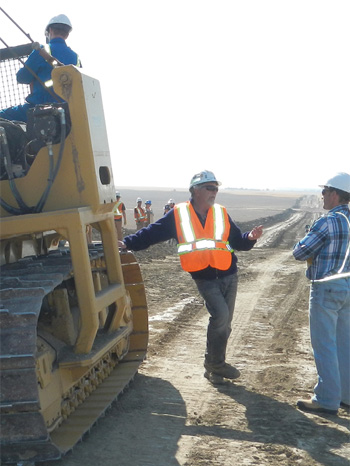 Historically, the WTI-Brent differential was mainly a consequence of differences in transportation and crude oil quality. In January 2011, the WTI-Brent differential began to widen and by 2012, it averaged approximately US$18 per barrel. This was primarily due to significant supply growth in western Canada and the U.S. midcontinent, coupled with a pipeline system essentially operating at capacity. As a consequence, there were considerable constraints to move crude oil through Cushing, Oklahoma, the pricing point for WTI.
Historically, the WTI-Brent differential was mainly a consequence of differences in transportation and crude oil quality. In January 2011, the WTI-Brent differential began to widen and by 2012, it averaged approximately US$18 per barrel. This was primarily due to significant supply growth in western Canada and the U.S. midcontinent, coupled with a pipeline system essentially operating at capacity. As a consequence, there were considerable constraints to move crude oil through Cushing, Oklahoma, the pricing point for WTI.
In addition, supply uncertainty caused mainly by geopolitical issues in the Middle East drove WTI oil prices to US$106 per barrel in the spring of 2012. As the year progressed, concerns about the state of the global economy, influenced by Europe’s weak economic recovery, reduced the WTI price of oil to approximately US$82 per barrel.
The decrease in WTI prices has affected other grades of oil including WCS and Edmonton Par. In 2012, the WTI-WCS differential averaged approximately $21 per barrel. Similarly, the WTI- Edmonton Par differential averaged approximately $8 per barrel.
Canada is a net crude oil exporter and the number one supplier of crude oil to the U.S. As seen in Figure 9, in 2012, total Canadian crude exports averaged approximately 2.3 MMb/d, which is a year-on-year increase of roughly eight per cent. In 2012, the total value of crude oil exports and imports is estimated at approximately C$70.7 billion and C$28.1 billion, respectively. Based on imports of 700 hundred thousand barrels of oil per day, it is estimated that if Edmonton Par crude oil were used, instead of the higher priced Brent crude, the total costs of imports in 2012 would have been lower by C$6.6 billion.
Figure 9 - Total Crude Oil Exports
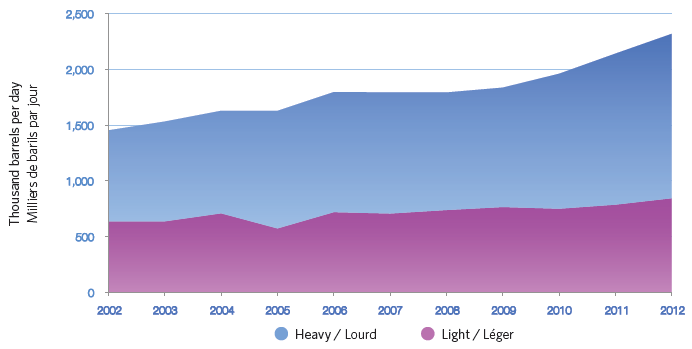
Natural gas prices (NYMEX) averaged US$2.79/MMBtu in 2012, 31 per cent below 2011 (US$4.04/MMBtu). Natural gas in 2012 traded in a range of US$2.04/MMBtu to US$3.70/MMBtu. In 2012, gas prices continued to be influenced by the increased availability of gas from unconventional sources, notably shale gas, as well as storage inventories and above average weather patterns.
Canadian natural gas production averaged 396.6 106m³/d (14.0 Bcf/d), a five per cent decrease from 2011 production of 416.4 106m³/d (14.7 Bcf/d). In 2012, natural gas exports averaged 243.6 106m³/d (8.6 Bcf/d), one per cent below 2011 exports of 246.5 106m³/d (8.7 Bcf/d). In 2012, pipeline imports averaged 79.3 106m³/d (2.8 Bcf/d), slightly higher than 2011 imports of 76.5 106m³/d (2.7 Bcf/d). Liquefied natural gas (LNG) imports averaged 4.8 106m³/d (0.17 Bcf/d), 47 per cent below 2011 imports of 9.1 106m³/d (0.32 Bcf/d) (Figure 10). The estimated value of net gas exports for 2012 is C$5.14 billion, a 38 per cent drop compared to 2011, resulting from significantly lower natural gas prices and somewhat increased imports.
Figure 10 - Monthly Natural Gas Exports and Imports
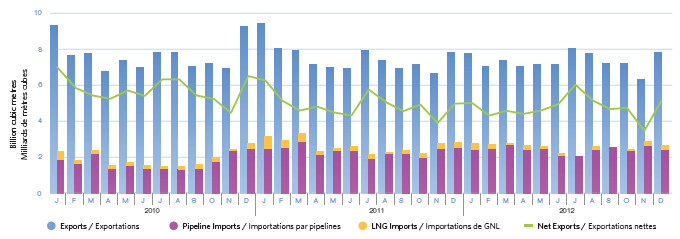
In 2012, net exports of electricity increased by 32 per cent from 2011 levels as seen in Figure 11. Exports rose by 13 per cent, but the growth in net exports is mostly attributable to the 32 per cent drop in imports. The largest declines in imports were observed in British Columbia, where high water levels increased the availability of hydroelectric supply, and Ontario, which has experienced periods of surplus baseload generation over the past few years. Total exports in 2012 were about 59 TW.h, worth approximately $2 billion. Despite rising exports, revenues from exports fell slightly in comparison to 2011. Imports in 2012 were about 11 TW.h, purchased for about C$209 million.
Figure 11 - Monthly Canadian Electricity Exports and Imports
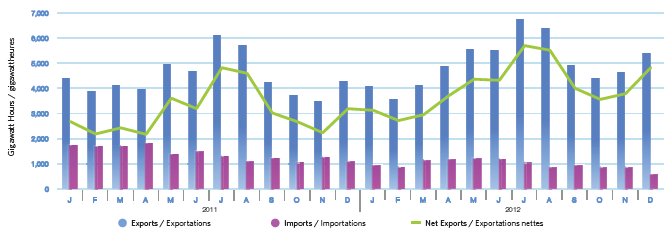
Electricity prices vary across Canada, largely due to the cost of resources available to generate electricity. Prices are lowest in the provinces dominated by hydro generation (e.g., Quebec, Manitoba and British Columbia) and higher in provinces with mainly thermal generation, including nuclear power (e.g., Nova Scotia, Ontario, Alberta). In 2012, average prices in most North American wholesale power markets dropped to a five-year low which led to the decline in export revenues.
Changes to Part VI of the NEB Act - Exports and Imports
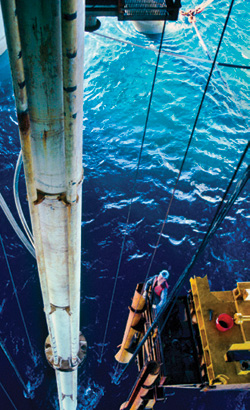 The Jobs, Growth and Long-term Prosperity Act amended Part VI (Exports and Imports) of the NEB Act streamlining the NEB’s review of oil, gas and electricity export and gas import applications.
The Jobs, Growth and Long-term Prosperity Act amended Part VI (Exports and Imports) of the NEB Act streamlining the NEB’s review of oil, gas and electricity export and gas import applications.
Hearings for export and import licences are no longer mandatory under section 118 of the NEB Act. For oil and gas exports, the NEB Act’s criteria focuses assessment of licence applications on ensuring the quantity of oil or gas to be exported does not exceed the surplus remaining after due allowance has been ma+de for the reasonably foreseeable Canadian requirements. For electricity, the amendments to the NEB Act mean that the criteria to consider electricity export licence applications will be: fair market access, the effect of the export on provinces other than that from which the electricity is to be exported, and considerations specified in the National Energy Board Electricity Regulations.
As a result of these changes, the Board will review and update related regulations for licence assessment processes to ensure they are consistent with the changes to the NEB Act.
NEB People and Culture
At the end of 2012, the Board had six permanent and seven temporary Members. The Board is supported by a staff of 401 full-time equivalents. NEB staff have a broad range of expertise needed to fulfill the organzation’s mandate as a quasi-judicial regulatory tribunal. The NEB is committed to developing, nurturing and maintaining that expertise through robust and focused learning and development initiatives.

A Flexible and Efficient Workplace
While this year marked a year of change for the NEB, one thing has not changed: our commitment to be an efficient and flexible organization. The Board is taking several steps to fulfill this commitment. We are implementing service standards and new integrated service delivery, enhancing our strategic management capacity to make sure strategic priorities are met, expanding our engagement with more multi-stakeholder advisory committees, and implementing the changes stemming from the Jobs, Growth and Long-term Prosperity Act.
The NEB People Strategy
The Board takes pride in its technical and professional excellence as a regulator, and strives to attract, retain and develop highly qualified staff to work in a dynamic, results-based culture of excellence. Employees are our most valued resource and we depend on them to make our goals a reality. In our People Strategy, we commit to providing the following value proposition to staff:
- interesting and challenging work in the national public interest;
- a workplace that supports learning and professional development;
- a supportive and inclusive workplace, underpinned by a strong culture of values;
- a work/life balance that works for each person;
- a competitive compensation package; and,
- effective leadership.
Employment Equity and Diversity
The National Energy Board is committed to employment equity and welcomes diversity in the workplace. A diverse workforce that mirrors the community strengthens the NEB and plays an important role in attracting and retaining talented employees.
In the past few years, the Board has enhanced employment equity and diversity programs and activities. This included re-establishing the Employment Equity and Diversity Committee. This committee has developed and is leading implementation of the Employment Equity Plan and related initiatives.
NEB is a Top 100 Employer in Canada!
In October of 2012, the NEB was named as one of Canada’s Top 100 Employers for 2013 for the third year in a row (the NEB is a four time winner as we were also named in 2009). In addition to that honour we were also named as one of Canada’s Top 100 Family Friendly Employers for 2013, a designation that recognizes employers offering progressive and forward-thinking programs for employees with young children, other dependents, and/or family responsibilities.
The Board is again excited to receive these honors as they showcase not only the types of programs offered to employees; they also focus on the employees themselves. The NEB is not just a Top 100 Employer and Family Friendly Employer; it is a “Top 100 Team” that strives for excellence in all that it does.

A Wealth of Experience
Complete biographies for current Members can be found on our website under Who we are & our Governance > Organization and Structure.
Gaétan Caron
Chair and CEO
Gaétan Caron was designated Chair and CEO of the NEB on 20 September 2007. Prior to assuming that role, he was Vice-Chair of the Board, having been appointed on 1 January 2005.
Mr. Caron obtained his Bachelor of Applied Science degree in Rural Engineering from Laval University in 1979 and his Master of Business Administration degree from the University of Ottawa in 1987. Mr. Caron has more than 33 years of regulatory experience at the National Energy Board.
Sheila Leggett
Vice-Chair
Sheila Leggett was appointed as a fulltime Board Member in September 2006. On 29 January 2008, Ms. Leggett was designated Vice-Chair.
Ms. Leggett has a Bachelor’s degree in Biology from McGill University and a Master’s degree in Biology from the University of Calgary. She has regulatory experience as well as a background in environmental issues.
Members
Roland George
Roland George joined the NEB as a permanent Board Member in August 2006.
Mr. George holds a Master of Business Administration (MBA) degree from École des Hautes Études Commerciales (1994; Montréal), a Master’s degree in Economics (MA) from Carleton University (1979; Ottawa) and a Bachelor of Science degree (BSc) in Mathematics (major) and Computer Science from McGill University (1977; Montréal).
Kenneth Bateman
Kenneth Bateman joined the NEB as a permanent Board Member in September 2006.
Mr. Bateman is an energy lawyer, former senior executive and nationally qualified arbitrator. He obtained a law degree from the University of Alberta (1984) and Masters of International Business Management from the American Graduate School of International Management (1995). His wide-ranging experience includes sustainable energy projects, the construction and operation of one of Canada’s largest wind farms and bio-waste remediation.
Georgette Habib
Georgette Habib joined the NEB as a permanent Board Member in October 2006.
Ms. Habib holds a Bachelor’s degree in Mathematics from the American University of Beirut and a Master’s degree in Economics from the University of Alberta. Prior to joining the National Energy Board, Ms. Habib had over 24 years of regulatory experience providing advice and expertise at the Energy Resources Conservation Board.
Lyne Mercier
Lyne Mercier joined the NEB as a permanent Board Member in December 2008.
Ms. Mercier holds a Bachelor’s degree in business administration from Saint Mary’s University, Halifax, and a graduate degree in oil company management from the École des Hautes Études Commerciales à Montréal. Prior to joining the Board Ms. Mercier had over 29 years in the natural gas industry.
Philip Davies
Philip Davies was appointed as a permanent Board Member of the NEB in 2012 effective January 2013.
Mr. Davies earned an ICD.D from the Institute of Corporate Directors at the University of Toronto, Rotman School of Management. He completed the Executive Development Program at the University of Western Ontario, Ivey School of Business and is a graduate of the University of Alberta, Faculty of Law. He is a member of the Law Societies of Alberta and Saskatchewan.
Temporary Members
David Hamilton
David Hamilton joined the NEB as a Temporary Member in October 2004. The Governor in Council re-appointed Mr. David Hamilton as temporary Board Member for a three-year term ending 30 June 2015.
Mr. Hamilton holds a Master’s degree in Leadership and Training from Royal Roads University, Victoria, B.C.. Mr. Hamilton has more than 30 years of experience working in the Northwest Territories in the development of communities through both the parliamentary and democratic processes.
Bob Vergette
Bob Vergette was appointed as a temporary Board Member of the NEB in December 2008. The Governor in Council re-appointed Mr. Bob Vergette as temporary Board Member for a three-year term ending in 2015.
Mr. Vergette has a Bachelor’s degree in Mechanical Engineering from the University of Alberta and is a graduate of the Banff School of Advanced Management. He is a member of the Association of Professional Engineers, Geologists and Geophysicists of Alberta. Mr. Vergette has extensive experience in pipeline engineering and operations including integrity management systems.
Hans Matthews
Hans Matthews was appointed as a temporary Board Member of the NEB in January 2010.
Mr. Matthews has a Bachelor of Science in Geology from Brock University and has completed course work towards a Master’s of Science at the University of Western Ontario. He is a professional geologist with more than 25 years experience in the mining, minerals and resource management industries. Mr. Matthews is a member of the Wahnapitae First Nation, Ontario, where he resides.
James Ballem
James Ballem was appointed as a temporary Board Member of the NEB effective May 2012. His term is for a period of three years.
Mr. Ballem graduated from University of Prince Edward Island (PEI) in 1976 with a Degree in Business Administration. He has held a number of senior government positions in PEI including Chair of the Standing Committee on Agriculture, Forestry and the Environment, Minister of Health and Social Services, Attorney General and Minister of Environment and Energy and Minister of Environment, Energy and Forestry.
Alison Scott
Alison Scott was appointed as a temporary Board Member of the NEB effective May 2012. Her term is for a period of three years.
Ms. Scott holds a Bachelor of Law degree from Dalhousie Law School. She has served in a number of other senior government positions in Nova Scotia, including Deputy Minister for the Department of Energy and Deputy Minister of Intergovernmental Affairs. She was called to the Nova Scotia Bar and is a former solicitor and litigator with the Nova Scotia Department of Justice.
Mike Richmond
Mike Richmond was appointed as a temporary Board Member of the NEB in November 2012. His term is for a period of three years.
Mr. Richmond is an energy lawyer whose practice focuses on electricity, renewables and utilities. He holds a law degree from the University of Toronto and a Bachelor of Social Sciences degree from the University of Ottawa, and was called to the Ontario Bar in 2000.
Jacques Gauthier
Jacques Gauthier was appointed as a temporary member of the NEB effective December 2012. His term is for a period of three years.
Mr. Gauthier has over 15 years of experience as a senior executive in the area of renewable energy, and he has served on a wide variety of boards and committees, including the Quebec Wildlife Foundation and the Prime Minister’s Advisory Committee on the Public Service.
Appendix A: Hearing Decisions Issued in 2012 (as of 31 December 2012)
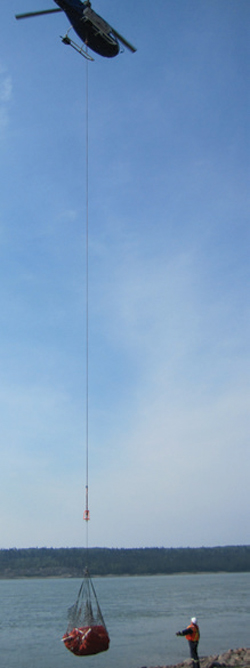 Leismer to Kettle River Crossover
Leismer to Kettle River Crossover
GH-004-2011
Nova Gas Transmission Ltd.
LENGTH: 77 km
COMMODITY: Gas
APPLICATION RECEIVED: 15 July 2011
HEARING DAYS: 1 day
DECISION RELEASED: 21 June 2012 [Filing A42334]
Line 9 Reversal - Phase I
OH-005-2011
Enbridge Pipelines Inc.
LENGTH: N/A
COMMODITY: Oil
APPLICATION RECEIVED: 8 September 2011
HEARING DAYS: 2 days
DECISION RELEASED: 27 July 2012 [Filing A43137]
Abandonment Empire Odourant
MHW-002-2011
St. Clair Pipelines Management Inc.
LENGTH: N/A
COMMODITY: Gas
APPLICATION RECEIVED: 2 May 2011
HEARING DAYS: Written
DECISION RELEASED: 5 January 2012 [Filing A38070]
Export LNG for 20 Years
GH-003-2011
BC LNG Export Cooperative LLC
LENGTH: N/A
COMMODITY: Gas
APPLICATION RECEIVED: 8 March 2011
HEARING DAYS: Written
DECISION RELEASED: 2 February 2012 [Filing A39041]
Vantage Pipeline Project
OH-3-2011
Vantage Pipeline Canada ULC
LENGTH: 578 km
COMMODITY: Oil
APPLICATION RECEIVED: 7 February 2011
HEARING DAYS: 0 days in 2012
DECISION RELEASED: 19 January 2012 [Filing A38581]
Northwest Mainline Extension
GH-002-2011
Nova Gas Transmission Ltd.
LENGTH: 111 km
COMMODITY: Gas
APPLICATION RECEIVED: 29 April 2011
HEARING DAYS: 0 days in 2012
DECISION RELEASED: 28 February 2012 [Filing A39577]
Tariffs No. 1 and No. 2
RH-1-2011
Enbridge Southern Lights GP Inc.
LENGTH: N/A
COMMODITY: Oil
APPLICATION RECEIVED: 31 May 2010
HEARING DAYS: 0 days in 2012
DECISION RELEASED: 9 February 2012 [Filing A39173]
Appendix B: Hearing Decisions Pending as of 31 December 2012
Northern Gateway Pipeline Project [Folder 620327]
OH-004-2011
Northern Gateway Pipelines Inc.
LENGTH: 2354 km
COMMODITY: Oil
APPLICATION RECEIVED: 27 May 2010
HEARING DAYS: 109 days in 2012
Business and Services Restructuring Proposal
and 2012 and 2013 Mainline Final Tolls [Folder 711778]
RH-003-2011
TransCanada PipeLines Limited
LENGTH: N/A
COMMODITY: Gas
APPLICATION RECEIVED: 1 September 2011
HEARING DAYS: 72 days
Preliminary Cost Estimates [Folder 782060]
MH-001-2012
Group 1 Companies
LENGTH: N/A
COMMODITY: N/A
APPLICATION RECEIVED: 29-30 November 2011
HEARING DAYS: 7 days
Northwest Mainline Komie North Extension [Folder 737909]
GH-001-2012
Nova Gas Transmission Ltd.
LENGTH: 130 km
COMMODITY: Gas
APPLICATION RECEIVED: 14 October 2011
HEARING DAYS: 10 days
Abandonment of Maple Creek [Folder 808133]
MHW-001-2012
Enerplus Corporation
LENGTH: N/A
COMMODITY: Gas
APPLICATION RECEIVED: 2 April 2012
HEARING DAYS: Written
Transportation Service and Tolls Methodology for Expanded Trans Mountain Pipeline System [Folder 828580]
RH-001-2012
Trans Mountain Pipeline ULC
LENGTH: N/A
COMMODITY: Oil
APPLICATION RECEIVED: 29 June 2012
HEARING DAYS: Not yet started
Application for Tariff effective 1 November 2011
and Tolls effective 1 January 2012 [Folder 811583]
RHW-001-2012
Centra Transmission Holdings Inc.
LENGTH: N/A
COMMODITY: Gas
APPLICATION RECEIVED: 19 September 2012
HEARING DAYS: Written
Chevron Priority Destination [Folder 825769]
MH-002-2012
Chevron Canada Limited
LENGTH: N/A
COMMODITY: Oil
APPLICATION RECEIVED: 19 June 2012
HEARING DAYS: Not yet started
Appendix C - Court Challenges to Board or GiC Decisions in 2012
 The following is a summary of challenges to Board decisions in 2012.
The following is a summary of challenges to Board decisions in 2012.
Lynx Canada Information Systems Ltd.
In June 2009, Geophysical Service Incorporated took legal action against Lynx Canada Information Systems Ltd. in the Alberta Court of Queen’s Bench for copyright infringement relating to geophysical information and related relief. On 27 May 2011, Lynx Canada Information Systems Ltd. brought a Third Party Claim against the National Energy Board. The file is presently ongoing.
Cenovus Energy Inc. - Application Regarding the Express Pipelines Ltd. Husky Lateral (MHW-1-2010)
On 24 June 2011, Express Pipelines Ltd. filed with the Federal Court of Appeal, a Notice of Motion for Leave to Appeal the Board’s MHW-1-2010 decision issued 26 May 2011, related to service and tolls on the Husky Lateral. The Court granted the Motion on 23 September 2011 and Express filed their Notice of Appeal with the Federal Court of Appeal on 21 November 2011. Express Pipelines Ltd. filed a Notice of Discontinuance with the Court on 14 March 2012.
NOVA Gas Transmission Ltd. - Final 2011 Tolls for the Alberta System and Implementation of Alberta System Integration
On 16 September 2011, Altagas Ltd. filed with the Federal Court of Appeal a Notice of Motion for Leave to Appeal of the NEB letter decision and Order TG-05-2011 dated 19 August 2011, approving Implementation of Alberta System Integration. On 19 September 2011, BP Canada Energy Company filed with the Federal Court of Appeal a Notice of Motion for Leave to Appeal the same NEB decision and Order. The Court granted both Motions on 10 November 2011. These files are presently ongoing.
Spectra South Peace Pipeline, Certificate GC-112 – Complaint by Peace River Greenhouses Ltd.
On 17 April 2012, Peace River Greenhouses Ltd. filed a Notice of Application to the Federal Court of Appeal to appeal the Board’s decision dated 23 March 2012. On 7 June 2012, the Court granted the application of Peace River Greenhouses Ltd. to convert its application to a Motion for Leave to Appeal. The Court dismissed the Motion for Leave to Appeal without reasons on 2 August 2012. On 16 October 2012, Peace River Greenhouses Ltd. filed a Motion to Set Aside the 2 August 2012 Court Order. The Court dismissed the Motion to Set Aside the 2 August 2012 Court Order on 27 November 2012.
Trans Mountain Pipeline ULC - Application for Firm Service to the Westridge Marine Terminal (RH-2-2011)
On 29 December 2011, Chevron Canada Limited filed with the Federal Court of Appeal, a Notice of Motion for Leave to Appeal the Board’s RH-2-2011 decision issued 1 December 2011. The RH-2-2011 decision related to an application for firm service on the Trans Mountain pipeline system for certain capacity to the Westridge Dock. The Court of Appeal dismissed the Motion without reasons on 15 February 2012.
On 13 February 2012, Chevron Canada Limited filed with the Federal Court of Appeal, a Notice of Motion for Leave to Appeal the Board’s letter decision dated 13 January 2012, in the matter of Trans Mountain Pipeline ULC application regarding Tariff #86 for the Trans Mountain Pipeline. The Court dismissed the Motion without reasons on 22 March 2012.
Appendix D - Certificates and Orders Oil
Orders Issued During 2012 Approving Oil Pipeline Facilities Including Pipeline Construction Not Exceeding 40 Kilometres in Length
| Enbridge Pipelines Inc. | XO-E101-001-2012 | 02/23/2012 | Application to install a connection from Tank 51 to Tank 52 at the Kerrobert terminal |
| Enbridge Pipelines Inc. | XO-E101-002-2012 | 02/27/2012 | Application to make modifications and additions to its existing Hardisty Terminal, Cromer Terminal and Kerrobert Station to optimize flow on Line 2 and Line 65 |
| Canadian Natural Resources Limited | XO-C298-003-2012 | 03/20/2012 | Application to construct and operate the Mica Creek 3 Gathering Pipeline |
| Enbridge Pipelines Inc. | XO-E101-004-2012 | 04/10/2012 | Application to construct a new bottom shell course on Tank 102 at the Cromer Terminal |
| Enbridge Pipelines Inc. | XO-E101-005-2012 | 04/19/2012 | Application to construct and operate the Waupisoo Meter Receipt Expansion |
| Enbridge Pipelines Inc. | XO-E101-006-2012 | 05/28/2012 | Application to construct the Gibson West Connections and Pipe Rack at EPI Hardisty Terminal |
| Enbridge Pipelines Inc. | XO-E101-008-2012 | 06/01/2012 | Application to complete modifications and additions to its existing Edmonton Terminal piping system, Lines 2 and 3 Surge Mitigation Project |
| Genesis Pipeline Canada Ltd. (Genesis) | XO-G062-009-2012 | 06/12/2012 | Application for the Genesis Extension Project |
| Plains Midstream Canada ULC | XO-P384-011-2012 | 08/20/2012 | Application to construct and operate a pipeline to replace the existing Milk River Pipeline |
| TransCanada Keystone Pipeline GP Ltd. | XO-T241-012-2012 | 08/24/2012 | Application to construct and operate the Keystone Hardisty Tank Terminal |
| Plains Midstream Canada ULC | XO-E103-014-2012 | 09/21/2012 | Application for deviation of the proposed route for the Milk River Replacement Project |
| Enbridge Pipelines Inc. | XO-E101-015-2012 | 12/05/2012 | Application for Line 4 surge mitigation |
| Enbridge Pipelines Inc. | XO-E101-010-2012 | 07/27/2012 | Application to reverse the segment of Line 9 (30 inch crude oil pipeline) from the Sarnia Terminal to the North Westover Station to flow in an eastward direction. In the reversed direction, crude would be delivered to the Westover Terminal from the Sarnia Terminal, with the bi-directional capability for the line to flow westward in the future maintained |
Appendix E - Certificates and Orders Gas
Orders Issued During 2012 Approving the Construction of Gas Pipeline Facilities Not Exceeding 40 Kilometres in Length
| Applicant | Order Number | Date Issued | Description |
| NOVA Gas Transmission Ltd. and Foothills Pipe Lines (Alta) Ltd. | XG-N081-002-2012 | 02/06/2012 | Application to construct and operate the Harmattan Straddle Plant connections |
| NOVA Gas Transmission Ltd. | XG-N081-003-2012 | 02/03/2012 | Application for the Northwest Mainline Expansion Project - Beaver Dams Removal |
| NOVA Gas Transmission Ltd. | XG-N081-004-2012 | 02/10/2012 | Application to construct and operate the Gordondale East Receipt Meter Station |
| Westcoast Energy Inc., carrying on business as Spectra Energy Transmission (Westcoast) | XG-W102-005-2012 | 03/13/2012 | Application to construct the T-North 2012 Expansion Project |
| NOVA Gas Transmission Ltd. | XG-N081-006-2012 | 03/15/2012 | Application to provide custody transfer measurement at a point of interconnection between the Transmission North (Zone 3) of the Westcoast pipeline system and NGTL’s NPS 36 Groundbirch Mainline |
| Alliance Pipeline Ltd. | XG-A159-007-2012 | 04/05/2012 | Application to construct and operate the Bear Creek Meter Station and interconnecting piping |
| TransCanada PipeLines Limited | XG-T211-008-2012 | 04/22/2012 | Application to construct and operate the Eastern Mainline Expansion project |
| NOVA Gas Transmission Ltd. | XG-N081-009-2012 | 05/29/2012 | Application to construct and operate of the Germain Sales Meter Station |
| Alliance Pipeline Ltd. | XG-A159-010-2012 | 06/12/2012 | Application for the Highway 43-32 Pipe Relocation Project |
| St. Clair Pipelines Management Inc. | XG-S402-011-2012 | 06/12/2012 | Application for the Bluewater River Crossing Replacement Project |
| Manitoba Hydro on behalf of Minell Pipeline Ltd. | XG-M234-012-2012 | 07/25/2012 | Application to replace and relocate a section of the Minell Natural Gas Pipeline at the Assiniboine River near St. Lazare, Manitoba, as it relates to new construction |
| NOVA Gas Transmission Ltd. | XG-N081-013-2012 | 08/03/2012 | Application to construct and operate the Dawes Lake North Sales Meter Station |
| NOVA Gas Transmission Ltd. | XG-N081-014-2012 | 08/22/2012 | Application to construct and operate the Wapasu Creek Sales Meter Station |
| TransCanada PipeLines Limited | XG-T211-015-2012 | 11/26/2012 | Application to construct and operate new and modified compression and ancillary facilities for the Station 130 (Maple) Compressor Upgrade Project, and under section 44 of the OPR-99 to deactivate four reciprocating compressors from the existing ‘A’ plant at Station 130 |
| NOVA Gas Transmission Ltd. | XG-N081-016-2012 | 04/12/2012 | Application to provide metering service for sweet natural gas to meet incremental delivery transportation service requirements for the proposed Hangingstone Sales Meter Station |
| Foothills Pipe Lines Ltd. | XG-F115-018-2012 | 12/12/2012 | Application for the Golden Prairie Sales Meter Station |
Endnotes
[1] The public interest is inclusive of all Canadians and refers to a balance of economic, environmental and social considerations that changes as society’s values and preferences evolve over time.
[2] 2012-2013 are estimated amounts.
[3]This value is derived from annual throughputs and the weighted average yearly commodity price.
[4] Data as of January 2013: incidents may still be under investigation data is reviewedand finalized after investigations are complete.

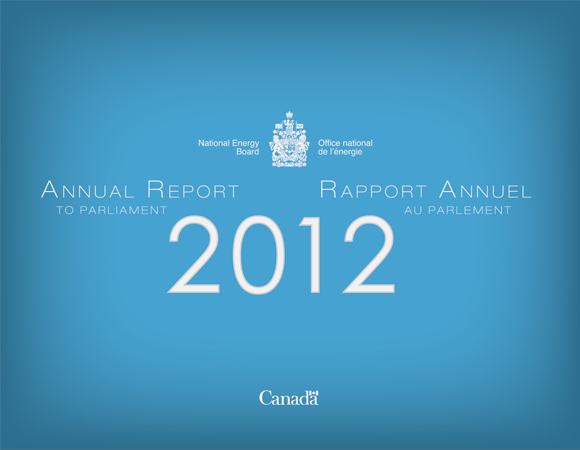
- Date modified:
